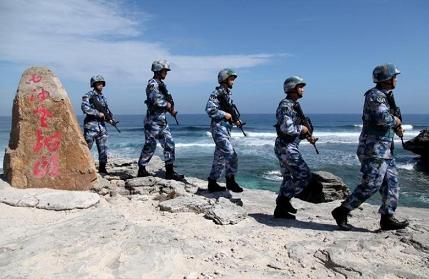by WorldTribune Staff, June 7, 2017
China is using non-military “coercion” in an effort to gain control of strategic waters in the Asian Pacific, the Pentagon said in its annual report to Congress released on June 6.
“China continues to exercise low-intensity coercion to advance its claims in the East and South China Seas,” the report said, adding that Beijing’s tactic involves the use of “timed progression of incremental but intensifying steps to attempt to increase effective control over disputed areas and avoid escalation to military conflict.”

Beijing’s maritime claims in the South China Sea were nullified last year by the United Nations Permanent Court of Arbitration. China rejected the court ruling and continues to assert sovereignty over some 90 percent of the sea.
On the use of coercion, the Pentagon report noted that China engages in punitive trade policies and other measures to deter opposition to its actions.
After the court ruling in July, China surged the numbers of coast guard, maritime militia, and fishing vessels around various disputed islands.
Chinese leaders are employing information warfare tactics short of armed conflict to advance strategic interests. “This approach seeks to enhance China’s influence through activities calculated to fall below the threshold of provoking the United States, its allies and partners, or others in the Asia-Pacific region into open conflict,” the report said. “This is particularly evident in China’s pursuit of its territorial and maritime sovereignty claims in the South and East China Seas.”
Beijing also continues to move ahead with the construction of military facilities on artificial islands in the South China Sea.
The island buildup has included major construction on larger islands with runways of 8,800 feet or longer, enough to handle troop transports and other warplanes, the Washington Free Beacon reported on June 7.
China’s new militarization has focused on three reclaimed islands – Fiery Cross, Subi, and Mischief Reefs – where small facilities were built last year.
“As of late 2016, China was constructing 24 fighter-sized hangars, fixed-weapons positions, barracks, administration buildings, and communication facilities at each of the three outposts,” the Pentagon report said.
“Once all these facilities are complete, China will have the capacity to house up to three regiments of fighters in the Spratly Islands,” the Pentagon said.
Other facilities have been built on four small islets, Johnson, Gaven, Hughes, and Cuarteron Reefs. The China’s People’s Liberation Army (PLA) in 2016 began to install fixed, land-based naval guns on each outpost and bolstered communications infrastructure on the reefs.
The Pentagon report challenged Beijing’s claim that the buildup is defensive and designed to improve working conditions on the outposts.
Instead, the goal of the PLA appears to be “attempting to bolster its de facto control by improving its military and civilian infrastructure in the South China Sea.”
“The airfields, berthing areas, and resupply facilities on its Spratly outposts will allow China to maintain a more flexible and persistent coast guard and military presence in the area,” the Pentagon report said.
Satellite photographs of the islands showed deployments of fixed-weapon positions and communications facilities.
A U.S. defense official said the weapons emplacements are a concern. The positions are currently equipped with short-range naval guns, but intelligence analysis indicates the same positions can be upgraded easily to handle longer-range anti-ship missiles.
The Beacon’s report said that the facilities, when fully militarized, “will give China sufficient power – mainly through PLA navy, maritime militia, and coast guard forces – to detect and counter activities by rival claimants and reduce the time needed to respond to rival naval and air activities.”
A U.S. Navy destroyer conducted a freedom of navigation operation near one of the reefs last month and more are expected.
Letters to the Editor __ Subscribe to Geostrategy-Direct __ Support Free Press Foundation
